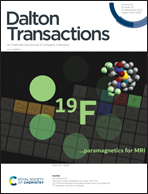Ruthenium(ii) polypyridyl complexes with visible light-enhanced anticancer activity and multimodal cell imaging†
Abstract
Ruthenium(II) polypyridyl complexes have drawn growing attention due to their photophysical properties and anticancer activity. Herein we report four ruthenium(II) polypyridyl complexes [(N^N)2RuII(L)]2+ (1–4, L = 4-anilinoquinazoline derivatives, N^N = bidentate ligands with bis-nitrogen donors) as multi-functional anticancer agents. The epidermal growth factor receptor (EGFR) is overexpressed in a broad range of cancer cells and related to many kinds of malignance. EGFR inhibitors, such as gefitinib and erlotinib, have been approved as clinical anticancer drugs. The EGFR-inhibiting 4-anilinoquinazoline ligands greatly enhanced the in vitro anticancer activity of these ruthenium(II) polypyridyl complexes against a series of human cancer cell lines compared to [Ru(bpy)2(phen)], but interestingly, these complexes were actually not potent EGFR inhibitors. Further mechanism studies revealed that upon irradiation with visible light, complexes 3 and 4 generated a high level of singlet oxygen (1O2), and their in vitro anticancer activities against human non-small-cell lung (A549), cervical (HeLa) and squamous (A431) cancer cells were significantly improved. Specifically, complex 3 displayed potent phototoxicity upon irradiation with blue light, of which the photo-toxicity indexes (PIs) against HeLa and A431 cells were 11 and 8.3, respectively. These complexes exhibited strong fluorescence emission at ca. 600 nm upon excitation at about 450 nm. A subcellular distribution study by fluorescence microscopy imaging and secondary ion mass spectrometry imaging (ToF-SIMS) demonstrated that complex 3 mainly localized at the cytoplasm and complex 4 mainly localized in the nuclei of cells. Competitive binding with ctDNA showed that complex 4 was more favorable to bind to the DNA minor groove than complex 3. These differences support that complex 3 possibly exerts its anticancer activities majorly by photo-induced 1O2 generation and complex 4 by binding to DNA.



 Please wait while we load your content...
Please wait while we load your content...